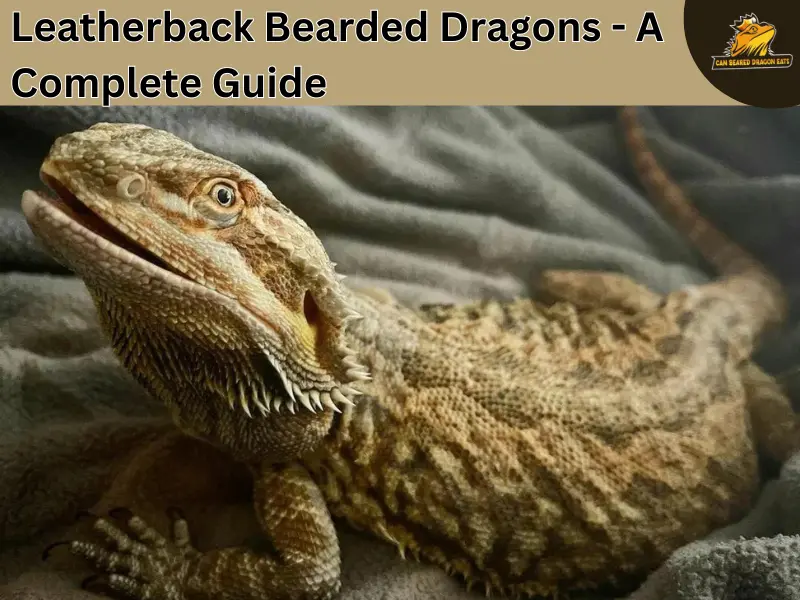Within the expansive community of reptile lovers, the Leatherback Bearded Dragon emerges as a captivating and mysterious creature. Its unique appearance and captivating demeanor have drawn the attention of pet enthusiasts worldwide. This comprehensive guide offers an in-depth exploration into the world of Leatherback Bearded Dragons, uncovering their distinctive characteristics, specific care requirements, and suitability as pets.
If you’re a seasoned reptile enthusiast or a newcomer to the hobby, understanding the intricacies of these creatures is essential for fostering a fulfilling relationship. From their striking appearance to their docile temperament, Leatherback Bearded Dragons have become a popular choice among reptile enthusiasts. By delving into their world, we can gain valuable insights into their needs and behaviors, ensuring that they thrive under our care. Join us as we embark on a journey to discover the allure and wonder of these remarkable reptiles, enriching our lives with their presence and companionship.
Read more : Blue Bearded Dragon – A Complete Guide
What is a Leatherback Bearded Dragon?
The Leatherback Bearded Dragon, scientifically known as Pogona vitticeps, is a morph variant of the traditional Bearded Dragon species. It earns its name from the distinctive absence of spiky scales on its back, replaced instead by smoother, leather-like skin. This genetic mutation results in a strikingly different appearance from the standard Bearded Dragon, making it a sought-after specimen among reptile enthusiasts.
Are Leatherback Bearded Dragons good pets?
Leatherback Bearded Dragons are esteemed as fantastic pets, thanks to their gentle disposition, which suits both novice and seasoned reptile enthusiasts. Their tranquil nature and ease of interaction make them ideal household companions. However, ensuring their contentment and health necessitates diligent care.
Providing a suitable habitat with proper temperature, lighting, and nutrition is paramount. Regular veterinary check-ups and attention to their specific needs contribute to their well-being. With attentive care and affectionate handling, Leatherback Bearded Dragons thrive as beloved additions to families, bringing joy and fascination to their owners’ lives.
Appearance and Characteristics of Bearded Dragons
Leatherback Bearded Dragons exhibit similar physical features to their traditional counterparts, with a few notable distinctions. While they possess the iconic triangular head and stout body characteristic of Bearded Dragons, their lack of spiky scales sets them apart. Instead, their skin boasts a smoother, more textured appearance, resembling leather, hence their name.
Leatherback Bearded Dragon Size
In terms of size, Leatherback Bearded Dragons generally reach lengths of 16 to 22 inches, with males typically being larger than females. Proper nutrition and habitat conditions are essential for ensuring healthy growth and development.
Leatherback Morph Bearded Dragon
The Leatherback morph in Bearded Dragons is a result of a genetic mutation affecting scale development. Unlike the traditional scaled appearance, Leatherbacks exhibit smoother skin, reminiscent of leather or suede. This unique variation has captivated reptile enthusiasts, contributing to their popularity in the pet trade.
Read more : Do Bearded Dragons Need Supplements?
How Long do Leatherback Bearded Dragons live?
Leatherback Bearded Dragons, like their traditional counterparts, have a relatively long lifespan when provided with proper care and husbandry. Understanding their lifespan is crucial for planning long-term care and commitment to these captivating creatures.
Average Lifespan
On average, Leatherback Bearded Dragons can live for approximately 10 to 12 years in captivity. However, with optimal care, some individuals have been known to surpass this lifespan and live into their teens or even early twenties.
Factors Affecting Lifespan
Several factors influence the lifespan of Leatherback Bearded Dragons, including genetics, diet, habitat conditions, and overall health. Providing a suitable environment with proper temperature gradients, UVB lighting, and a nutritious diet is essential for promoting longevity.
Healthcare and Veterinary Support
Regular veterinary check-ups and prompt medical attention for any health concerns are crucial for ensuring the well-being and longevity of Leatherback Bearded Dragons. Routine examinations can help detect and address potential health issues early, improving their quality of life and lifespan.
Read more : Enhance Your Bearded Dragons Lifespan
Leatherback Bearded Dragon Care
Maintaining optimal living conditions is paramount to the health and happiness of Leatherback Bearded Dragons. This includes providing a spacious enclosure with appropriate temperature gradients, UVB lighting, and a substrate that allows for burrowing. Regular cleaning and maintenance of their habitat, along with access to fresh water and nutritious food, are essential for their overall welfare.
What are the Feeding Habits of Leatherback Bearded Dragons?
Feeding Habits of Leatherback Bearded Dragons
Diet Composition
Leatherback Bearded Dragons are omnivores, requiring a balanced diet of both animal protein and plant matter. Their diet primarily consists of insects, leafy greens, and occasional fruits.
Protein Requirements
Juvenile Leatherbacks have higher protein requirements for growth and development. Offer a variety of live insects such as crickets, roaches, and mealworms to meet their protein needs.
Vegetable Consumption
As adults, Leatherback Bearded Dragons should consume more vegetables than protein. Offer a diverse selection of leafy greens such as kale, collard greens, and mustard greens, along with vegetables like squash and bell peppers.
Calcium and Vitamin Supplementation
Ensure proper calcium and vitamin supplementation to prevent metabolic bone disease. Dust insects with calcium powder and provide a vitamin supplement as recommended by a reptile veterinarian.
Feeding Schedule
Offer food daily for juveniles and every other day for adults. Adjust portion sizes based on individual appetite and activity levels, ensuring they maintain a healthy weight.
Read more : Can bearded dragons eat peas?
Conclusion
Leatherback Bearded Dragons are fascinating reptiles that have captured the hearts of pet enthusiasts worldwide. With their unique appearance, docile temperament, and relatively low maintenance requirements, they make excellent companions for reptile lovers of all levels. By understanding their nature, providing proper care, and respecting their individual needs, we can forge fulfilling relationships with these remarkable creatures for years to come.
- Eastern Bearded Dragon - July 26, 2024
- Why Do Bearded Dragons Bob Their Heads? - July 25, 2024
- Everything You Need to Know About Paradox Bearded Dragons - July 10, 2024

